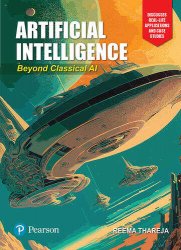Artificial Intelligence: Beyond Classical AI
- Добавил: literator
- Дата: 24-04-2024, 18:30
- Комментариев: 0
 Название: Artificial Intelligence: Beyond Classical AI
Название: Artificial Intelligence: Beyond Classical AIАвтор: Reema Thareja
Издательство: Pearson
Год: 2024
Страниц: 881
Язык: английский
Формат: epub
Размер: 20.9 MB
Pearson’s Artificial Intelligence encompasses a comprehensive text on the fundamental principles and concepts of Artificial Intelligence—a new-age technology that fuels the much-coveted ‘Industry 4.0’. Presented in lucid English, this book covers all the basic concepts, enriched with latest examples. It also discusses all the major components of AI, such as Neural Networks, Natural Language Processing, Reinforcement Learning, Machine Learning, Deep Learning and Computer Vision. The book is a deliberation of classical as well modern AI techniques and related technologies that provides readers with an overall knowledge and understanding of AI in present-day context.
Few languages that are popularly used to code AI applications are R, Python and Java. From a layman’s view, artificial intelligence (AI), simply means the intelligence demonstrated by machines that help them to mimic the actions of humans. AI simulates natural intelligence in machines that are programmed to learn from experiences, adjust to new inputs and perform human-like tasks. From a researcher’s view, AI is a set of algorithms that generates results without having to be explicitly instructed to do so, thereby making machines capable of thinking and acting rationally and humanely.
Most AI examples, from chess-playing computers to self-driving cars, heavily depend on Deep Learning and natural language processing (NLP) techniques.
AI applications perform specialized tasks by processing large amounts of data and recognizing patterns in them. Besides learning from experience, AI applications can recognize objects, understand and respond to language and make decisions to solve real-world problems. AI perform tasks that normally require human intelligence. The main focus of this technology is to build machines and algorithms which are capable of performing computational tasks that would otherwise require human-like brain functions. While computers execute certain tasks like sorting, computing, memorizing, indexing, finding patterns, etc. far better than humans, they still cannot beat human skills for identifying emotions, recognizing faces, communication and conversation. This is where AI will play a crucial role to enable machines achieve human capabilities.
Majority of AI systems are supported by breakthroughs in Machine Learning and Deep Learning techniques. These techniques together go hand-in-hand to deliver an efficient system that sometimes it is just difficult to understand the difference between Artificial Intelligence (AI), Machine Learning and Deep Learning. However, venture capitalist Frank Chen highlighted this difference by stating ‘Artificial Intelligence is a set of algorithms and intelligence to try to mimic human intelligence. Machine Learning is one of them, and Deep Learning is one of those Machine Learning techniques.’
In simple words, Machine Learning techniques are used to feed data in to the computer so that statistical techniques can be applied to it to help machines ‘learn’ how to solve tasks or which it had not been specifically programmed. These computers free programmers from writing several lines of code. Machine Learning techniques can be further classified into supervised learning (using labelled data sets) or unsupervised learning (using unlabelled data sets).
Deep Learning is an advanced Machine Learning technique that passes data inputs through a biologically-inspired multiple layers of neural network. Such a neural network architecture consists of a number of hidden layers through which the data is processed. Data processed in this architecture allows machines to go ‘deep’ in its learning, making connections and weighting input for the best results.
Features:
Focusses on practical implementation of key algorithms using Python programming language that help students gain hands-on experience
Supplements theoretical concepts with projects and interview questions
Discusses real-world case studies to illustrate pragmatic applications
Includes exhaustive coverage on Prolog programming language
Provides extensive chapter-end exercises for practice
Contents:
Скачать Artificial Intelligence: Beyond Classical AI
Внимание
Уважаемый посетитель, Вы зашли на сайт как незарегистрированный пользователь.
Мы рекомендуем Вам зарегистрироваться либо войти на сайт под своим именем.
Уважаемый посетитель, Вы зашли на сайт как незарегистрированный пользователь.
Мы рекомендуем Вам зарегистрироваться либо войти на сайт под своим именем.
Информация
Посетители, находящиеся в группе Гости, не могут оставлять комментарии к данной публикации.
Посетители, находящиеся в группе Гости, не могут оставлять комментарии к данной публикации.

